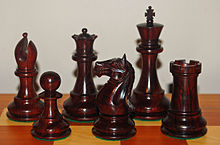Pterocarpus santalinus
- "Red Sandalwood" redirects here. See also: Algum.
| Pterocarpus santalinus | |
|---|---|

| |
| in Talakona forest, in Chittoor District of Andhra Pradesh, India. | |
| Scientific classification | |
| Kingdom: | |
| (unranked): | |
| (unranked): | |
| (unranked): | |
| Order: | |
| Family: | |
| Subfamily: | |
| Tribe: | |
| Genus: | |
| Species: | P. santalinus
|
| Binomial name | |
| Pterocarpus santalinus | |
Pterocarpus santalinus (Telugu: రక్తచందనము (raktachandana), (Tamil: சிவப்புச்சந்தனம் (ciwappuccantanam); Red Sanders or Red Sandalwood) is a species of Pterocarpus native to India.[1] It is only found in south India in Kadapa, Chittoor, mostly in the hilly region of Nepal, in Pakistan and in Sri Lanka.[2] [3][4]. In Nepal sandalwood is one main and lucrative market for smugglers as a high price is paid for this wood in China. Since, the exporting of sandlewood was legalised in Nepal, the underground market is growing and there are a number of arrests every year of those trying to smuggle this wood to China.

It is a light-demanding small tree growing to 8 m tall with a trunk 50–150 cm diameter. It is fast-growing when young, reaching 5 m tall in three years even on degraded soils. It is not frost tolerant, being killed by temperatures of −1 °C. The leaves are alternate, 3–9 cm long, trifoliate with three leaflets. The flowers are produced in short racemes. The fruit is a pod 6–9 cm long containing one or two seeds.[5][6][7]
Uses
The wood has historically been valued in China, particularly during the Ming and Qing periods, referred to in Chinese as zitan (紫檀) and spelt tzu-t'an by earlier western authors such Gustav Ecke, who introduced classical Chinese furniture to the west[4]. It has been one of the most prized woods for millennia. King Solomon was given tribute logs of Almug in Sanskrit valgu, valgum by the Queen of Sheba[8] Due to its slow growth and rarity, furniture made from zitan is difficult to find and can be expensive [8]. Between the 17th and 19th centuries in China the rarity of this wood led to the reservation of zitan furniture for the Qing dynasty imperial household. Chandan, the Indian word for Red Sandalwood which is Tzu-t’an, are linked by etymology. The word tan in Chinese is a perfect homonym of “tan”, meaning cinnabar, vermillion and the cognition is suggested by the interchange of chan for oriflamme, the vermilion ensign of the ancients. Chinese traders would have been familiar with Chandan. Tzu-t’an then is the ancient Chinese interpretation for the Indian word chandan for red sandalwood.
In Hinduism, this wood has been traditionally used as a sacred wood. The priests and higher class casts such as brahamin extensively use this wood on many of their rituals.
The other form of zitan is from the species Dalbergia luovelii, Dalbergia maritima, and Dalbergia normandi, all similar species named in trade as bois de rose or violet rosewood which when cut are bright crimson purple changing to dark purple again. It has a fragrant scent when worked[4].
Grading of red sanders

It is observed that the red sanders grown on the shale type of subsoil, at an altitude of 750 meters above mean sea level and in semi-arid climatic conditions gives a distinctive wavy grain margin and the wood pieces with the wavy grain margin are graded as "A" grade. Red sanders with wavy grain margin fetch a higher price than the non-wavy wood.
Conservation status
This species is listed as Endangered by the IUCN, because of overexploitation for its timber. [9]
References
- ^ International Legume Database & Information Service: Pterocarpus santalinus
- ^ HG Richter and MJ Dallwitz. "Commercial timbers - Pterocarpus santalinus". Retrieved 27 September 2012.
- ^ IBNlive.com article on Red Sandalwood about to become extinct
- ^ a b c http://www.chinese-furniture.com/cgi-bin/ccf.cgi?stt=stp&pgn=newsletter_archive/newsletter_2.html&id= Chinese Furniture.com newsletter; Volume 1, Number 2; Accessed 2007-04-05
- ^ Herbalcureindia: Pterocarpus santalinus
- ^ FAO Ecocrop: Pterocarpus santalinus
- ^ Auroville: Wasteland reclamation through rehabilitation of eroded soil (pdf file)
- ^ a b http://www.wctg.net/zitan.html; Accessed 2007-04-06
- ^ [1]
http://www.jstor.org/pss/594922 http://www.iucnredlist.org/apps/redlist/details/32104/0

